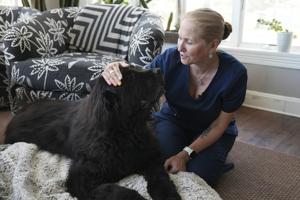NEW YORK (AP) — Dr. Lisa Walling’s first house call of the day was with a particularly fluffy hospice patient — a 13-year-old Newfoundland named Rugby. Rugby happily licked a plate of peanut butter as Walling inserted needles along her back; acupuncture and a ketamine injection to help with pain and mobility problems.
As an end-of-life care veterinarian, Walling considers both pet and owner to be her patients. She’s there to make sure animals are as comfortable as possible in their final days, and help humans through the difficult decision of knowing when it’s time to say goodbye. “I find a lot of the time, the biggest part of my job is helping the owners,” said Walling.

When it came time to euthanize Rugby at a later visit, the whole family was there. There are a number of options available to help aging pets and their caregivers, including hospice and palliative care, at-home euthanasia and a growing number of so-called pet death doulas. But navigating decisions around the end of their life can still feel overwhelming.
Here are some ways you can take care of your pet and yourself. How can I make my elderly pet more comfortable? Hospice and palliative care veterinarians like Walling specialize in home visits, which can be a good option if transporting your pet to the vet’s office becomes too difficult. The International Association for Animal Hospice and Palliative Care maintains a of its members.
Vets can prescribe medication to treat infections, pain and ch.
















